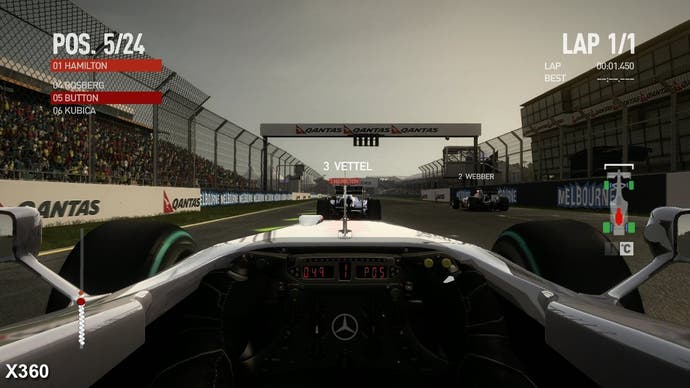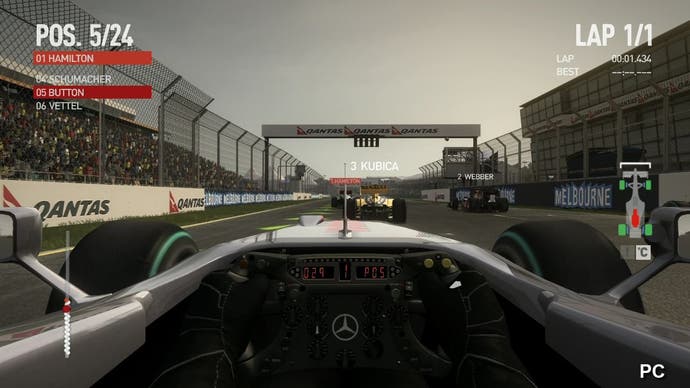Face-Off: F1 2010
Constructors championship.
As the table demonstrates quite clearly, the PC version offers official support for the widest range of steering wheel hardware - as good a point as any to segue across to an evaluation of the computer version of F1 2010. We'll kick off with a PC/PS3 comparison for a change, but as always we've provided an alternative version featuring the competing console platform for those interested.
The PC rendition of F1 2010 follows the template set by DiRT 2 in terms of taking the console version (360 specifically, by the look of it) then using EGO engine features to leverage some of the additional horsepower available via the more modern GPUs many gaming machines possess. Of course, the basics are there - you can run F1 at any resolution you want and you can set your own anti-aliasing and anisotropic filtering levels to suit the level of GPU power you have available.
A fully-enabled F1 with a decent graphics card allows for 60FPS gameplay, more refined visuals via an FP16 framebuffer, less aggressive shadow cascades, what looks like higher-precision water shaders with higher-quality reflections, more generous particle LODs in wet-weather racing... the list goes on. Plus, of course, there's more support for more steering wheels.
F1 on PC also appears to have hidden support for DirectX 11 rendering, as these fans on the F1 community forum have uncovered. It's highly likely that Codemasters will officially support DX11 properly in the future, hopefully with a more impressive feature-list than that uncovered by the enthusiasts.
Interestingly, several of the reports for the DX11 hack point out that loading times are dramatically reduced and it's worth pointing out that this is one area of the PC game that could really use some work in its default setting - despite running an extremely fast Samsung F1 1TB drive, F1 2010 on PC has slower loading times than its console equivalents.
Codemasters recommends a 2.66GHz Core 2 Duo or Athlon X2 4200+ CPU in concert with an NVIDIA 9800GT or Radeon HD 4850. However, this article shows an enormous round of GPU testing, albeit with an overclocked Core 2 Quad, which should give you some idea of how the game scales.


The bottom line seems to be that Codemasters' recommended spec should give console-style performance at 720p or 1280x1024, but in concert with a decent CPU, those same GPUs may struggle at higher resolution unless you lower the anti-aliasing down from the mammoth 8x MSAA used in their tests. Regardless, once again it seems that a relatively inexpensive graphics card in concert with a fast dual-core processor should easily outstrip image quality and performance offered by both Xbox 360 and PlayStation 3.
Overall, Codemasters is to be commended on what is an excellent cross-platform release. The PC version is the pick of the bunch with its refined visuals, support for higher resolutions and higher-quality art. It's disappointing that DX11 support is currently only available via an unofficial config tweak with limited results, but hopefully a forthcoming official patch should allow cutting edge PC owners to reap more of a reward from their investment in newer graphics hardware. However, F1 does also serve to highlight the negative impacts of console development too - the geometry levels are pegged to console levels and while the PC game can make use of less aggressive LODs, there is still undeniably the sense that even entry-level enthusiast GPUs are capable of so much more.
In terms of the console versions, it's obvious that there's no clear, outright winner here as each release has its own strengths and weaknesses. With raw captures run direct through our analysis tools, there's little doubt that the PS3 version offers a marginally higher performance level and fewer torn frames - but the actual benefit of that in-game isn't so readily apparent. Its support for 7.1 and DTS audio is also welcome compared to the hardware limited Dolby Digital 5.1 on 360. On the flipside, the QAA blur on PS3 is an integral component of F1's look and definitely a weakness up against the pristine appearance of the 4x MSAA on 360.
However, for many the graphical advantage won't matter much. More practical to hardcore enthusiasts is the support for steering wheel peripherals, and here the PS3 commands a clear advantage with some of the best racing hardware supported.
Check out our F1 2010 review for an in-depth gameplay appraisal.








